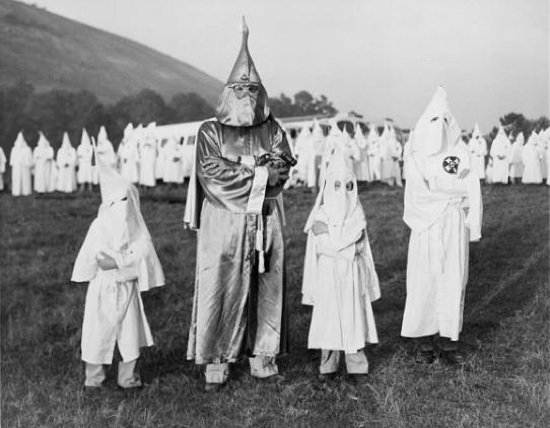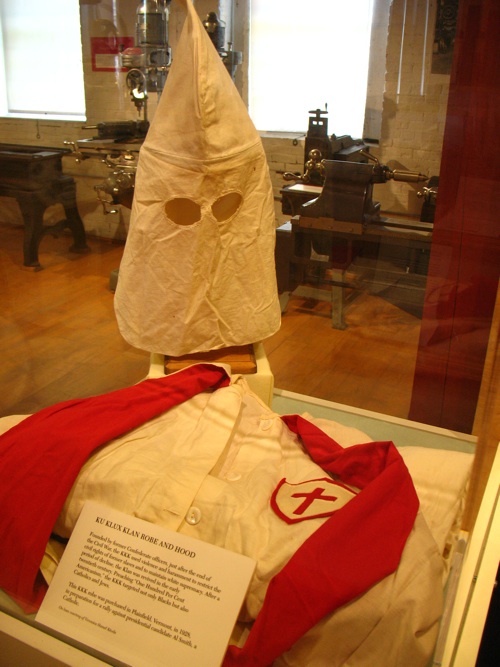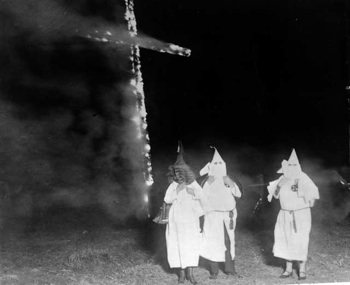
Kelly J. Baker
At midnight on November 25, 1915, seventeen men climbed to the top of Stone Mountain in Georgia with a large wooden cross. On that Thanksgiving night, they lit the cross on fire and pledged allegiance to the U.S. Constitution, American ideals, and “the tenets of the Christian religion.”[1] The fiery cross marked the beginning of the second order of the Ku Klux Klan. Its founder, William Simmons, looked back to the Reconstruction Klan for inspiration, but also sought a different path from those earlier Klansmen. Simmons, who named himself the first Imperial Wizard of the order, and his successor, Hiram Wesley Evans, imagined the new Klan as a patriotic and Christian order distinct from the violence and vigilantism of the earlier Klan.
D.W. Griffith’s film, Birth of a Nation (1915) and its romanticized rendition of the Reconstruction Klan inspired Simmons to recreate the Knights of the Ku Klux Klan for the early twentieth century. The film, based on Thomas F. Dixon’s book, The Clansman (1905), visualized the Reconstruction era as a time of peril for white men, women, and children. There were dangerous black politicians, the rape of the white women, deep unease about the enfranchisement of African Americans, and heroic Klansmen attempting to save the Southerners from a disastrous fate. The Klansmen of Birth of a Nation spurred Simmons to reimagine the order for the early twentieth century as defenders of not just the South, but the nation as a whole. African Americans emerged as one of many threats including Catholics, Jews, and immigrants. By October 1915, Simmons recruited 34 members to compose his Knights, including a few veterans from the Reconstruction Klan. The cross burned on Stone Mountain marked the beginning of a new Klan fighting to save a white Protestant nation.
Only nine years later in 1924, the order’s membership peaked at four million members in all 48 of the continental states.[2] The robes and the fiery cross, the most recognizable artifacts of the Klan, materialized the order’s commitment to Protestantism and 100% Americanism. The Klan’s material culture tells the story of both their popularity and decline 100 years later. Their shared vision of white Protestant nation defended by Knights in robes no longer appeals as it once did, but it lingers still.

The Reconstruction Klan created the distinctive uniform: long, white robes decorated with various occult symbols and tall hoods with aprons, or masks. The uniforms evoked the ghosts of the Confederate dead, and Klansmen employed them to terrify African Americans and sympathetic white people.[3] The 1920s Klan adopted the uniform from the Reconstruction Klan, but changed it to mimic the Klansmen of Birth of a Nation. The robes were more than disguise or throwback. Simmons wrote:
Every line, every angle, every emblem spells out to a Klansman his duty, his honor, responsibility and obligation to his fellow men and to civilization…All of it was woven into the white robes of the Ku Klux Klan for the purpose of teaching by symbolism the very best things in our national life.[4]
The average Klansman’s uniform consisted of a belted white robe with cross patch, hood, and mask. The robe is long and shapeless, with stitches, seams, buttons, and roped belt. Its shapelessness is fundamentally important: covering bodies from neck to wrist and from wrist to feet. Only the wearer’s hands, calves, and feet appear visible. A deep red patch on the chest interrupts its whiteness. Inside the patch resides a cross with a teardrop shape in its center. The cross symbolized the order’s commitment to Christianity while the teardrop symbolized the blood Jesus shed to redeem humanity. The color of the robes displayed the requirements for membership: white, Protestant, and “native-born” American, all understood as white.
According to a report by an Exalted Cyclops (a Klan leader) in the Klan newspaper, Imperial Night-Hawk, Klansmen wore “this white robe to signify the desire to put on that white robe which is the righteousness of Christ, in that Empire Invisible, that lies out beyond the vale of death.”[5] To wear the robe was to wear Jesus’s example on your body. When Klansmen put on their uniforms, they commemorated the life and death of Jesus. The robes materialized the Klan’s theology as well as their white supremacy. The mask wiped away the last traces of the individual men and equalized Klansmen. They became part of the larger order. The Texas Klan leader wrote:
Who can look upon a multitude of white robed Klansmen without thinking of the equality and unselfishness of that throng of white robed saints in the Glory Land? May the God in Heaven, who looks not upon outward appearance, but upon the heart, find every Klansman worthy of the robe and mask that he wears. Then when we ‘do the things we teach’ and ‘live the lives we preach,’ the title of Klansman will be the most honorable title among men.[6]
The motto of the Klan “not for self, but others” was realized in the Indistinguishable multitude. Yet, an individual Klansman’s action could make the Klan appear more honorable or terrible. The collective, after all, was made up of men who didn’t always commit to all the Klan required. The order’s control was never quite complete. Imperial Wizard Evans warned that unofficial use of regalia was “a direct violation of the rules of this Order and must be discontinued.” The Night-Hawk reminded that “untold damage might easily result from such practices.”[7]
Klansmen did not always practice what the Klan preached. The Klan’s artifacts, however, did much of the preaching.
The fiery cross shored up the Klan’s vision of a white Protestant nation. Simmons was also responsible for adding the fiery cross to 1920s Klan’s rituals. Thomas Dixon’s The Clansman introduced the idea of the burning crosses as a part of the Reconstruction Klan’s mythology. In the novel, the cross functioned to bind this American Klan to the Scottish clans of lore and a larger history of Anglo-Saxons; it was a tool to communicate with other Klans. The order recrafted the fiery symbol from Dixon’s staging to emphasize the Klan’s messages of 100% Americanism and Protestantism.
As one of the seven sacred symbols of the Klan, the cross was:
A sign of the Christian religion….Sanctified and made holy nearly nineteen hundred years ago by the suffering and blood of the crucified Christ, bathed in the blood of fifty million martyrs who died in the most holy faith, it stands in every Klavern of the Knights of the Ku Klux Klan as a constant reminder that Christ is our criterion of character…[8]

However, it was not just a cross, but a fiery cross. For the Klan, fire symbolized that Christ was the “light of the world.” Light vanquished the darkness and superstitions. “[T]he fire of Calvary’s cross” purified Klansmen of their sins and virtue was all that remained. An Exalted Cyclops wrote, “Who can look upon this sublime symbol, or sit in its sacred, holy light without being inspired with a holy desire and determination to be better man? ‘By this sign we conquer.’”[9] The Klan hoped that the fiery cross inspired Klansmen to become better Christian men, but also warriors who would conquer anyone opposed to them. Klansmen yearned to recapture the hearts and minds of the nation that would maintain a white Protestant nation. Their battle was a crusade for their way of life. Christ’s light might have emanated from this burning cross, but this artifact also rallied “the forces of Christianity” to battle the “hordes of the anti-Christ” and the “enemies” of Americanism: Catholics, Jews, and African Americans.[10]
The cross was also a warning to those who “threatened” the nation. According to the Imperial Night-Hawk, the fiery cross was the “emblem of real Americanism,” which “flashed its message of a Nation Reborn.”[11] Faith and nation were inseparable. Faith built the boundaries and marked certain religious traditions and races as unable to assimilate into American culture. For Imperial Wizard Evans, Klan’s goal was to maintain “a Christian civilization in America.” Evans wrote, “Pre-eminence is enjoined upon us by God and by our obligations to the world. If the Klan aspires to purify America and make her impregnable, it is not any selfish reason.” [12] The Klan’s work was divinely ordained. America, in all her glory, needed to maintain her Protestantism, or the future of the nation might be in peril.
By wearing white robes under the light of the fiery cross, the 1920s Klan hoped to save America. Robes and crosses materialized their hope. Yet, the fiery cross and robes did not offer comfort or assurance to the Klan’s victims. They only found fear and terror, not religious symbolism or national pride. The meanings of artifacts are always contested. Sometimes the meaning you choose is not the one that lasts.
In recent years, the robes and fiery cross no longer appear attached the Klan’s Protestantism, but rather both emerge as ready symbols of the Klan’s virulent racism. The long history of Klansmen committing acts of terrorism means that robes and fiery crosses appear as hypervisible signs of white supremacy. They’re inseparable from how we interpret and understand the Klan, and we cannot seem to abide such obvious signs racial hatred in the twenty-first century. The Klan might try to rebrand, but their material culture betrays their attempts. We think we know what the order once stood for, and they’ll have a hard time convincing us otherwise. The scorn directed at the Klan’s artifacts reflect the order’s decline 100 years later.
While the 1920s Klan boasted membership numbers in the millions, recent estimates suggest that modern Klans only have 3000-5000 members. The modern Klans, unlike their nineteenth and early twentieth century predecessors, are no longer one large, centralized organization but rather consist of many smaller, fragmented organizations. Some have local and regional chapters, websites and newsletters, but all that connects these groups is the use of the Klan name, material culture, and the defense of white supremacy. As of 2014, there are only 74 chapters in the United States, down from 221 chapters in 2010. No longer is the Klan a dominant cultural force, but rather Klansmen appear as marginal and fringe. Other white supremacist movements continue to gain members. Writing at Slate, Brian Palmer notes that younger racists tend to think of the Klan as “their grandfather’s hate group.” Despite the decline in influence, the Klan still remains a steadfast part of the cultural landscape. They pass out fliers, burn crosses to intimidate people, and rally in support of the Confederate flag.
The robes still contain religious value. Photojournalist Anthony Karen followed “Ms. Ruth,” a contemporary seamstress of Ku Klux Klan robes and other miscellaneous hate regalia in 2008 as she creates and blesses each robe. Karen appears stumped by Ms. Ruth. She’s an Aryan outfitter after all, but she fosters good relationships with her customers, whom she describes as “good people” and “Christian.” Ms. Ruth even explained that the Klan is a force of good and benevolence, which protected and still protects, the rights of white citizens.
In several of Karen’s photos, Ms. Ruth blesses each robe by holding it on her chest and closing her eyes. She wraps her thin arms tightly around the garment and says: “God bless the person who wears this robe.”
Artifacts are still essential to the Klan after 100 years. Christianity remains essential too. After all of these years, the Klan, despite declining membership rolls, still exists. I wonder what the decline says about modern America. While some would rush to suggest that dwindling membership reflects an increasing commitment to racial equality and detachment from spectacular forms of racism, I remain unconvinced. The Klan remains in the news cycle. A few chapters have threatened action if a monument to Martin Luther King, Jr., is added to Stone Mountain. While white Americans might find the Klan’s robes and burning crosses less compelling than they once did, white supremacy isn’t going anywhere. White people might not join the Klan in record numbers anymore, but they still join racist groups. The Klan might be out of fashion, but white supremacy is not. The robes and fiery crosses bear witness to that truth.
Kelly J. Baker is a freelance writer with a Religious Studies PhD who covers higher education, gender, labor, motherhood, American religions, and popular culture. She is the author of Gospel According to the Klan: The KKK’s Appeal to Protestant America (2011) and The Zombies are Coming! (2013). She can be followed @kelly_j_baker.
[1] William Simmons, Official Message of the Emperor of the Invisible Empire, Knights of the Ku Klux Klan, to the Initial Session of the Imperial Klonvokation, Atlanta, GA: Webb & Vary Print, 1922, D.C. Stephenson Collection, M264, b.4, f.8, Indiana Historical Society.
[2] Wade, The Fiery Cross: The Ku Klux Klan in America (New York: Oxford University Press, 1987), 253.
[3] Wade, Fiery Cross, 33-34. Wyn Wade described the Reconstruction uniform in detail. Elaine Parsons has written that the Reconstruction robes need to be understood as spectacle. She looks at the theatrical roots of this Klan and the symbolic import of the robes. For more on the Reconstruction robes, see Elaine Frantz Parsons, “Midnight Rangers: Costume and Performance in the Reconstruction-Era Ku Klux Klan,” The Journal of American History, 92:3, 811-836.
[4] Simmons, The Klan Unmasked, 88.
[5] Exalted Cyclops of Texas, “The Seven Symbols of the Klan,” Imperial Night-Hawk, 1:39, (December 26, 1923), 7. Emphasis original. Empire Invisible is a play off Invisible Empire, their term of Klandom. Empire Invisible refers to the celestial realm.
[6] Exalted Cyclops, “The Seven Symbols of the Klan,” 7. Emphasis Original.
[7] “Mis-use Of Regalia Is Reported,” Imperial Night-Hawk, 1:39, (December 26, 1923), 5.
[8] “The Seven Symbols of the Klan,” Imperial Night-Hawk, 1:39, (December 26, 1923), 6.
[9] “The Symbol of the Fiery Cross,” 8.
[10] Simmons, The Klan Unmasked, 33.
[11] “The Fable of the Eagle and the Buzzards,” Imperial Night-Hawk, 1:4, (April 25, 1923), 3.
[12] “Dr. Evans, Imperial Wizard, Defines Klan Principles…” Imperial Night-Hawk, 1:43, (January 23, 1924), 2.
